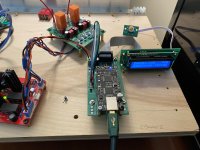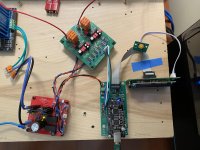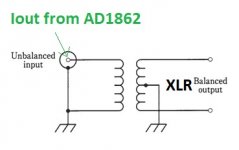Could you share the DD I/V circuit your using with the AD1862 dac?
The OPA828 looks good to try also.
Sure, look at Painkiller dac here at diya, iy's this one I have.
The Digital input selector based on the AK4118 chip arrived. It has SPDIF x4 + USB x1 inputs to I2S output with a screen that shows locked status and sampling rate. Works very nice! No pops/clicks when switching inputs either 🙂
Attachments
Sure, look at Painkiller dac here at diya, iy's this one I have.
How did You get it?!
The Digital input selector based on the AK4118 chip arrived. It has SPDIF x4 + USB x1 inputs to I2S output with a screen that shows locked status and sampling rate. Works very nice! No pops/clicks when switching inputs either 🙂
nice device 🙂 do you hear any sound difference between spdif/i2s and usb/i2s directly on this AD1862 DAC? 🙂
How did You get it?!
By luck in fact.
Don't look any opa860 in the link nore Thorsten Losch? while there was the 660 already used. My memory tells me it was : AD844, then opa660 (no feedback) then its sucessor opa860. There was in between an ADA something too (or at buffer after the 660 in the old Ayas ?
Edit : oh I see : last post of the link 😉 , think the design is older from the AD844 when these cool people was talking together in an other forum ?
Last edited:
I got this set-up fired up at 2AM 😱
I only switched between optical and USB and listened for a short time to confirm all worked as it should. I’m also curious if there is any sound degradation between SPDIF signal and USB to I2S.
I only switched between optical and USB and listened for a short time to confirm all worked as it should. I’m also curious if there is any sound degradation between SPDIF signal and USB to I2S.
The Digital input selector based on the AK4118 chip arrived. It has SPDIF x4 + USB x1 inputs to I2S output with a screen that shows locked status and sampling rate. Works very nice! No pops/clicks when switching inputs either 🙂
Nice!
Could you post the links where did you buy the input selector and the regulator?
Thanks
@surfparadise,
Here is the Audiophonics link:
Digital Input Selector AK4118 SPDIF x4 USBx1 20 pin to I2S output With screen - Audiophonics
@diyiggy,
Thanks for the tip, this is just a testing bed. When I’m ready to properly house in a chassis, good wiring procedures will follow.
Who knows when that will be though, I think settling on and I/V solution is going to take some time. 😀
Here is the Audiophonics link:
Digital Input Selector AK4118 SPDIF x4 USBx1 20 pin to I2S output With screen - Audiophonics
@diyiggy,
Thanks for the tip, this is just a testing bed. When I’m ready to properly house in a chassis, good wiring procedures will follow.
Who knows when that will be though, I think settling on and I/V solution is going to take some time. 😀
Caro Diggy.. 🙂
The shown circuit is only that far actual, that Vunce could literally take it as it is, and apply to his 860 circuit. The two are pin compatible, function compatible, 860 is the legacy product after the defunct OPa660..
Take note of the discussed base damping resistors, (pin3, pin5..) etc..
Ciao, George
The shown circuit is only that far actual, that Vunce could literally take it as it is, and apply to his 860 circuit. The two are pin compatible, function compatible, 860 is the legacy product after the defunct OPa660..
Take note of the discussed base damping resistors, (pin3, pin5..) etc..
Ciao, George
Member
Joined 2006
Simple I/V for TDA1541
See post #16 moment of the birth of the opa660 I/V circuit by Thorsten in Jan 2003.
and post #21 the AD844 inspiration to Pedja.
But all preceded by Charles Hansen (Ayre) in 2001 or so:
Ayre CD player? - AVS Forum | Home Theater Discussions And Reviews
Ayre CX-7 CD player (2002) already using 4 stacked AD844s per channel in the IV section. 😉
See post #16 moment of the birth of the opa660 I/V circuit by Thorsten in Jan 2003.
and post #21 the AD844 inspiration to Pedja.
But all preceded by Charles Hansen (Ayre) in 2001 or so:
Ayre CD player? - AVS Forum | Home Theater Discussions And Reviews
Ayre CX-7 CD player (2002) already using 4 stacked AD844s per channel in the IV section. 😉
Caro Diggy.. 🙂
The shown circuit is only that far actual, that Vunce could literally take it as it is, and apply to his 860 circuit. The two are pin compatible, function compatible, 860 is the legacy product after the defunct OPa660..
Take note of the discussed base damping resistors, (pin3, pin5..) etc..
Ciao, George
yup,
think it will benefice of more filtering on the voltage prg chip with 1 to 2 uF film // to more than 470 uF. and a Tip 142 emitter follower something... where did I see that 😉
Simple I/V for TDA1541
See post #16 moment of the birth of the opa660 I/V circuit by Thorsten in Jan 2003.
and post #21 the AD844 inspiration to Pedja.
But all preceded by Charles Hansen (Ayre) in 2001 or so:
Ayre CD player? - AVS Forum | Home Theater Discussions And Reviews
Ayre CX-7 CD player (2002) already using 4 stacked AD844s per channel in the IV section. 😉
Well done Cheung 🙂
I used to think it started at AVS Forum.
All ok but but.. I still have that breadboarded opa660 circuit, and I used Thorsten's schematic for sure..
And it can not be later than 2001... He used to have his own page, maybe it was there..?
And it can not be later than 2001... He used to have his own page, maybe it was there..?
who knows ?
Diyiggy digging falls on that about this story of transimpedance and feedback for noise after reading wikipedia : A low noise single-transistor transimpedance preamplifier for Fourier-transform mass spectrometry using a T feedback network
a discrete / opa hybride
Diyiggy digging falls on that about this story of transimpedance and feedback for noise after reading wikipedia : A low noise single-transistor transimpedance preamplifier for Fourier-transform mass spectrometry using a T feedback network
a discrete / opa hybride
I am new on this thread and the AD1862 DAC is so tempting. If I using output transformer with XLR output, any suggestion?
and can I omit the I/V part?
Thanks
and can I omit the I/V part?
Thanks
@miro1360
Are you modifying the original design of this DAC adding the voltage regulator part or a passive I/v or we could consider the actual design as final release?
Are you modifying the original design of this DAC adding the voltage regulator part or a passive I/v or we could consider the actual design as final release?
The trafo also needs an I/V resistor, either in parallel with the primary or secondary of the trafo.
Not sure of the advantages of having it on primary or secondary, I think if the primary winding resistance is too high the IV resistor must be on the primary.
My trafo does not have centre tap on the secondary and it can still drive a balanced input, not sure if thats possible with all trafos though.
The trafo is an awfully expensive option and probably wont outperform either a passive IV resistor without a trafo or op amp IV, simply has its own set of compromises.
The trafo is probably the most ''natural'' sounding but the least transparent option to my ears.
Actually ''least transparent'' is not really accurate, least consistently transparent would be more correct, it depends a lot on the music how well it performs.
Not sure of the advantages of having it on primary or secondary, I think if the primary winding resistance is too high the IV resistor must be on the primary.
My trafo does not have centre tap on the secondary and it can still drive a balanced input, not sure if thats possible with all trafos though.
The trafo is an awfully expensive option and probably wont outperform either a passive IV resistor without a trafo or op amp IV, simply has its own set of compromises.
The trafo is probably the most ''natural'' sounding but the least transparent option to my ears.
Actually ''least transparent'' is not really accurate, least consistently transparent would be more correct, it depends a lot on the music how well it performs.
Last edited:
- Home
- Source & Line
- Digital Line Level
- DAC AD1862: Almost THT, I2S input, NOS, R-2R


